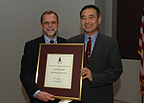April 27, 2007
Archaeologist Shimada named top scholar at SIUC

Caption follows story
He will receive $7,500 in cash and $7,500 in professional development support as part of SIUC's "Excellence Through Commitment Awards Program," established in 2004, and will have the right to use the title "Distinguished Scholar" after his name. He also receives a wristwatch courtesy of the SIU Alumni Association and a personal parking space for a year.
The University honored Shimada and other Excellence Award winners at a dinner hosted by interim Chancellor John M. Dunn Thursday, April 26, at the Student Center.
Shimada, widely regarded both here and abroad as one of the leading Central Andean scholars, has spent nearly three decades in Peru unearthing clues to the lives and times of the Moche and Sicán peoples, ancient inhabitants of the country's northern coast. Known for their pyramidal tombs, fine ceramics and metalwork, the Moche flourished from about 50 to 800 A.D., while the Sicán era lasted from about 700 to 1370 A.D.
Shimada's doctoral research at the Moche site Pampa Grande was described by Henning Bischof, retired director of ethnological collections at the Reiss-Englehorn Museum in Mannheim, Germany, as "groundbreaking." But Bischof and others who wrote to support Shimada's nomination for the prize all pointed to his Sicán archaeological project, begun in 1979, as unique in the field.
"In order to tease out from the site the information needed to understand this society, he has studied the monumental and domestic architecture, the settlement patterns, and the ceramic and metallurgical workshops," wrote Steve Bourget, associate professor of art and art history at the University of Texas at Austin.
"To gain a better understanding of their craft production, he and his colleagues have even replicated the techniques used in the making of ceramic and metallic artifacts. He has also conducted ground-penetrating radar surveys which led to the discovery of numerous outstanding funerary contexts. In these deeply buried complex burials chambers many individuals were placed with hundreds of finely crafted objects, many of them made from precious metals."
Noted Bischof, "It is mainly due to Dr. Shimada's work that original contexts (architectural, ritual, funerary) have been scientifically documented … that otherwise would have been destroyed by treasure hunters."
Anne Marie Hocquenghem of the French Institute of Andean Studies in Lima, Peru, wrote that Shimada's discovery of the Sicán ability to mass produce arsenical copper, a form of bronze, explained how and why the society flourished.
"In short," she wrote, "he offers us the evidence of the beginnings of the Bronze Age in the Americas. To this day, no one, to my knowledge, has fully explored the implications of Dr. Shimada's crucially important insight in the history of pre-Hispanic American societies."
Colleagues also pointed to Shimada's energetic efforts to engage those not in his field with the fruits of his research through public lectures, television appearances (including a feature on the Discovery channel), and museum displays not only in Peru but in countries such as Japan, Europe and a multi-million dollar exhibition now traveling through Canada.
In addition, he raised several million dollars to build the Sicán National Museum in Ferrenafe, Peru, where materials he unearthed can be stored and displayed and where scholars can conduct research. Peru has twice honored Shimada, once in 1993 with its Medal of Merit for Distinguished Service and last December with its Medal of Honor.
J. Scott Raymond, professor of archaeology at the University of Calgary, noted that most archaeologists who, like Shimada, spend long periods of time in the field do not produce the volume of published work that is the mark of a true scholar.
"(They) fall behind in the analysis … and find themselves with a backlog of unpublished material late in their careers," he wrote.
"Not so with Izumi. I count 57 peer-reviewed journal articles, 73 book chapters and 10 books to his credit. Moreover, his publications have had a significant impact on the archaeology of Peru specifically and archaeological theory generally."
Shimada joined SIUC as an assistant professor in 1994, was promoted to associate professor in 1996 and became a full professor in 2002. He earned his bachelor's in 1971 from Cornell University and his doctorate in 1976 from the University of Arizona.
Caption: Top scholar – Interim SIUC Chancellor John M. Dunn (left) congratulates archaeologist Izumi Shimada, the University’s 2007 Outstanding Scholar.
Photo by Steve Buhman